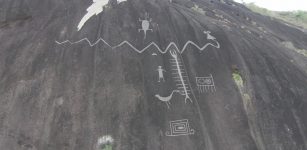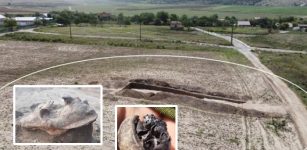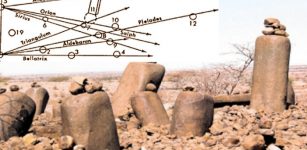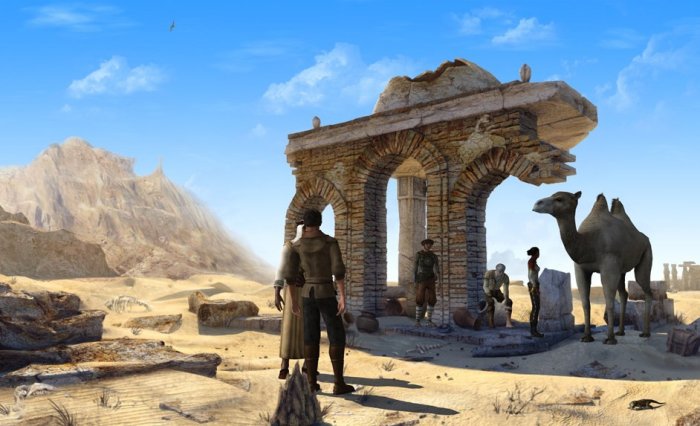Zerzura – Lost Ancient Sahara Oasis Guarded By Black Giants
Ellen Lloyd - AncientPages.com - For as long as anyone can remember, people have been fascinated with the possibility of discovering ancient lost cities. Explorers have gone on the most dangerous expeditions to find fabled riches of lost cities and sometimes they were successful.
Many amazing lost cities have been found underwater, in the desert, and in the jungles, but some mysterious ancient places still remain in the realm of mythology. The fact that we haven’t found them yet doesn’t necessarily imply they do not exist.
There are myths and legends about a lost ancient oasis hidden in the Sahara Desert. Its name is Zerzura, and it's supposed to be located somewhere deep in the desert west of the Nile River in Egypt or Libya.
An anonymous 15th-century Arabic treasure seeker guide, "Kitab al Kdnuz" (The Book of Hidden Pearls), describes Zerzura as a whitewashed city of the desert on whose gate is carved a bird. The treasure seeker is advised to "take with your hand the key in the beak of the bird, then open the door of the city. Enter, and there you will find great riches..."
The lost desert city, which is "white as a dove" and often called "The Oasis of Little Birds", is the resting place of a sleeping King and Queen.
Although some ancient authors say it’s possible to visit Zerzura, old myths say the oasis is guarded by black giants who prevent anyone from entering and leaving this enigmatic place.
Tracing the origin of the Zerzura legend is difficult. Greek historian Herodotus (484 - 425 B.C.) mentions a legendary known as 'The City of Dionysus' that is lost in the desert sands. This could be a reference to Zerzura.
Credit: Screenshot from Lost Chronicles of Zerzura
The first European references to Zerzura are by the English Egyptologist John Gardner Wilkinson in his book "Topography of Thebes and a General View of Egypt" published in 1835. His account was based on a report by an Arab who said he found the oasis while searching for a lost camel, but Wilkinson doesn’t provide a specific location of the lost oasis.
Explorers found many unknown oases mentioned in Wilkinson’s book but didn’t find the legendary Zerzura itself.
Count Ladislas (Lazlo) de Almasy, one of the best pilots in the Hungarian airforce, heard the legend of a fabulous lost oasis of Zerzura. He became determined to find it. In 1932 the Almásy- Patrick Clayton expedition reconnaissance flights discovered two valleys in the Gilf Kebir, a plateau in the New Valley Governorate of the remote southwest corner of Egypt, and southeast Libya.
Almásy discovered the third of the "Zerzura" wadis - rain oases in the remote desert, but despite a systematic search by Almasy, no ruins of any lost city were ever found.
What Changed The Green Sahara Into A Desert?
Zerzura, the legendary lost city filled with treasures and the sleeping king and the queen does still only exists as a mythological place.
Was Zerzura swallowed by the desert? Perhaps Zerzura is much older than we think. There was a time in the distant past when Sahara was green. Scientists have discovered that ancient rivers that existed about 100,000 years ago created green corridors across Sahara.
It’s also possible that Zerzura never existed outside men's imaginations. Currently, we do not know the truth about this fascinating place.
Updated on March 5, 2024
Written by - Ellen Lloyd – AncientPages.com
Copyright © AncientPages.com All rights reserved. This material may not be published, broadcast, rewritten or redistributed in whole or part without the express written permission of AncientPages.com
Expand for referencesMore From Ancient Pages
-
 Tomte – A Beloved Scandinavian Christmas Gnome
Christmas Traditions | Dec 24, 2024
Tomte – A Beloved Scandinavian Christmas Gnome
Christmas Traditions | Dec 24, 2024 -
 Neolithic Watermelons Reveal Some Surprises About Our Ancestors
Archaeology | Aug 6, 2022
Neolithic Watermelons Reveal Some Surprises About Our Ancestors
Archaeology | Aug 6, 2022 -
 Largest Ever Recorded Ancient Petroglyphs Found In Venezuela – Mapped
Archaeology | Dec 10, 2017
Largest Ever Recorded Ancient Petroglyphs Found In Venezuela – Mapped
Archaeology | Dec 10, 2017 -
 Modern Humans Have Their Homeland In Botswana – New Study
Archaeology | Oct 29, 2019
Modern Humans Have Their Homeland In Botswana – New Study
Archaeology | Oct 29, 2019 -
 Pyrgi Gold Tablets: A Rare Ancient Bilingual Treasure
Artifacts | Nov 23, 2018
Pyrgi Gold Tablets: A Rare Ancient Bilingual Treasure
Artifacts | Nov 23, 2018 -
 Archaeologists Make An Unusual Find In A 2,000-Year-Old Romanian Burial Mound
Archaeology | Jul 12, 2023
Archaeologists Make An Unusual Find In A 2,000-Year-Old Romanian Burial Mound
Archaeology | Jul 12, 2023 -
 Discovery Of Queen Nefertiti’s Mummy Will Be Announced Next Month – Zahi Hawass Says
Archaeology | Sep 16, 2022
Discovery Of Queen Nefertiti’s Mummy Will Be Announced Next Month – Zahi Hawass Says
Archaeology | Sep 16, 2022 -
 Sinuses Prevented Prehistoric Crocodile Relatives From Deep Diving
Evolution | Nov 7, 2024
Sinuses Prevented Prehistoric Crocodile Relatives From Deep Diving
Evolution | Nov 7, 2024 -
 On This Day In History: Battle Of King’s Mountain Was Fought – On Oct 7, 1780
News | Oct 7, 2016
On This Day In History: Battle Of King’s Mountain Was Fought – On Oct 7, 1780
News | Oct 7, 2016 -
 Biblical Cherubim – Sweet Angels Or Dangerous Creatures With A Hidden Agenda?
Ancient Mysteries | Jun 9, 2018
Biblical Cherubim – Sweet Angels Or Dangerous Creatures With A Hidden Agenda?
Ancient Mysteries | Jun 9, 2018 -
 The Four Bases Of Anti-Science Beliefs – What Can Be Done About Them?
News | Jul 14, 2022
The Four Bases Of Anti-Science Beliefs – What Can Be Done About Them?
News | Jul 14, 2022 -
 Fire Reveals Notre-Dame De Paris Cathedral Was Historical First In Using Iron Reinforcements In The 12th Century
Archaeology | Mar 17, 2023
Fire Reveals Notre-Dame De Paris Cathedral Was Historical First In Using Iron Reinforcements In The 12th Century
Archaeology | Mar 17, 2023 -
 Exploring Future Evolution: How Will Humans Change In The Next 10,000 Years?
Featured Stories | Oct 3, 2022
Exploring Future Evolution: How Will Humans Change In The Next 10,000 Years?
Featured Stories | Oct 3, 2022 -
 Cartography Shows That The Isthmus Of Tehuantepec Was Used As An Inter-Oceanic Passage In The 16th Century
Archaeology | Oct 21, 2022
Cartography Shows That The Isthmus Of Tehuantepec Was Used As An Inter-Oceanic Passage In The 16th Century
Archaeology | Oct 21, 2022 -
 Evidence Europeans Made Leather Clothing 40,000 Years Ago – New Study
Archaeology | Apr 17, 2023
Evidence Europeans Made Leather Clothing 40,000 Years Ago – New Study
Archaeology | Apr 17, 2023 -
 10 Norse Gods Who Vikings Gained Strength From
Featured Stories | May 14, 2018
10 Norse Gods Who Vikings Gained Strength From
Featured Stories | May 14, 2018 -
 Namoratunga – Kenya’s Fascinating Megalithic Site Oriented Toward Specific Stars And Constellations
Featured Stories | Jul 6, 2021
Namoratunga – Kenya’s Fascinating Megalithic Site Oriented Toward Specific Stars And Constellations
Featured Stories | Jul 6, 2021 -
 Graves Of Celtic Princes Reveal How Powerful Women Were In Pre-Roman Germany
Archaeology | Jun 4, 2024
Graves Of Celtic Princes Reveal How Powerful Women Were In Pre-Roman Germany
Archaeology | Jun 4, 2024 -
 New West Papua Findings Provide Insights Into Early Human Migration To The Pacific
Featured Stories | Aug 13, 2024
New West Papua Findings Provide Insights Into Early Human Migration To The Pacific
Featured Stories | Aug 13, 2024 -
 First Pompeiian Human Genome Sequenced Fron An Individual Who Died After The Eruption Of Mount Vesuvius In 79 C.E
Archaeology | May 26, 2022
First Pompeiian Human Genome Sequenced Fron An Individual Who Died After The Eruption Of Mount Vesuvius In 79 C.E
Archaeology | May 26, 2022



